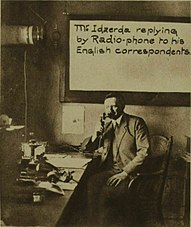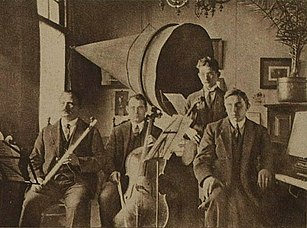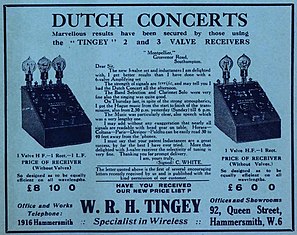
AM broadcasting is radio broadcasting using amplitude modulation (AM) transmissions. It was the first method developed for making audio radio transmissions, and is still used worldwide, primarily for medium wave transmissions, but also on the longwave and shortwave radio bands.

WHA is a non-commercial radio station, licensed since 1922 to the University of Wisconsin and located in Madison, Wisconsin. It serves as the flagship for the Wisconsin Public Radio talk-based "Ideas Network". WHA's programming is also broadcast by FM station WERN in Madison. The station airs a schedule of news and talk programs from Wisconsin Public Radio, NPR, American Public Media, Public Radio International, the Canadian Broadcasting Corporation and the BBC.
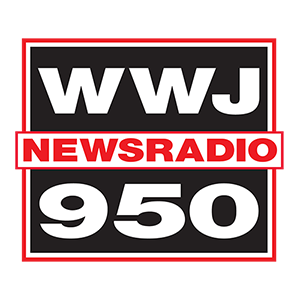
WWJ is a commercial AM radio station licensed to serve Detroit, Michigan, featuring an all-news radio format known as "Newsradio 950 WWJ". Owned by Audacy, Inc., the station services Metro Detroit, is the market affiliate for CBS News Radio, and the flagship station for the Michigan Sports Network. Operating on a regional broadcast frequency, its studios are in the Panasonic Building in Southfield.
KQV is a non-commercial radio station in Pittsburgh, Pennsylvania, and covering the Greater Pittsburgh Region. Owned by Broadcast Educational Communications, the station simulcasts WKGO in Murrysville and airs an easy listening radio format. KQV is one of the oldest radio stations in North America.

WNYM – branded "AM 970 The Answer" – is a commercial radio station licensed to Hackensack, New Jersey, and serving the New York metropolitan area. The station is owned by Salem Media Group and programs a conservative talk radio format. Its studios are shared with co-owned WMCA on Broadway in Lower Manhattan.

CINW was the final call sign used by an English language AM radio station in Montreal, Quebec, which, along with French-language sister station CINF, ceased operations at 7:00 p.m. ET on January 29, 2010. Owned and operated by Corus Quebec, it broadcast on 940 kHz with a full-time power of 50,000 watts as a clear channel, Class A station, using a slightly directional antenna designed to improve reception in downtown Montreal.

KDKA is a Class A, clear channel, AM radio station, owned and operated by Audacy, Inc. and licensed to Pittsburgh, Pennsylvania, United States. Its radio studios are located at the combined Audacy Pittsburgh facility in the Foster Plaza on Holiday Drive in Green Tree, and its transmitter site is at Allison Park. The station's programming is also carried over 93.7 KDKA-FM's HD2 digital subchannel, and is simulcast on FM translator W261AX at 100.1 MHz.

WRUC is an independent educational college radio station, owned and operated by Union College in Schenectady, New York. The station transmits with an effective radiated power of 100 watts, providing coverage over an approximate 15-mile radius. WRUC also streams its programming on Internet radio. The station's offices and studios are located in the Reamer Campus Center on the Union College campus.
KLZ is a commercial radio station licensed to Denver, Colorado and owned by Crawford Broadcasting. KLZ received its first broadcasting license on March 10, 1922. It is the oldest broadcasting station in the state of Colorado, and one of the oldest in the United States.

WGI was an early radio broadcasting station, licensed to the American Radio and Research Corporation (AMRAD) of Medford Hillside, Massachusetts. WGI received its initial broadcasting license on February 7, 1922. However, the station had previously made regular broadcasts under an experimental license as 1XE, which were the first organized broadcasts in the Boston area.
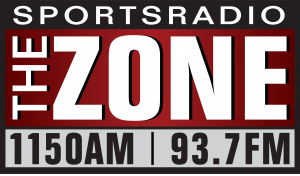
KZNE, branded as "The Zone 1150 AM – 93.7 FM", is a commercial sports radio station licensed to serve College Station, Texas. Owned by the Bryan Broadcasting Company, KZNE covers College Station, Bryan and much of the Brazos Valley. Studios are located in College Station, with a transmitter site in Bryan.
WQB was a radio station, located in Hartford, Connecticut, that was licensed to the C. D. Tuska Company from August 22, 1921 to June 24, 1922. Although it was never formally classified as being a broadcasting station by the United States government, it was one of the first stations in the U.S. to make regular broadcasts intended for the general public, and many contemporary publications included it in their broadcasting station reviews.

NOF was one of the call signs used in the 1920s by a radio station located at the Naval Air Station in Anacostia, D.C. This call sign was used when the station was making general and experimental broadcasts, while the call sign NSF was generally used when the station was conducting regular business. From 1920 to 1922 the Anacostia station was the primary radio outlet employed by the U.S. government for making public broadcasts. However, in early 1923 responsibility for these programs was transferred to station NAA in Arlington, Virginia, and the Anacostia station returned to generally being used for research, thus primarily using the NSF call sign. However, a few public demonstrations, most notably Charles Jenkins' mid-1920s television experiments, were later conducted under the NOF call sign.
KFC was a Seattle, Washington AM radio station that was licensed from December 8, 1921 to January 23, 1923. The station was owned by the Northern Radio & Electric Company, however both its studio and transmitter were located at the Seattle Post-Intelligencer building, and the newspaper was responsible for most of its operations.

WMH was an AM radio station in Cincinnati, Ohio, which was licensed to the Precision Equipment Company from December 30, 1921, to December 11, 1923, although it ceased broadcasting in early January 1923. It was one of the first formally authorized broadcasting stations in the United States, and also the first licensed in the state of Ohio.
WDW was a very short-lived AM broadcasting station, licensed to the Radio Construction & Electric Co. in Washington, D.C., which was issued an initial license in December 1921, and deleted a few months later.
WJH was a Washington, D.C. AM radio station, which was first authorized in December 1921, and went silent in mid-1924. It was originally licensed to the White & Boyer Company, which later became the William P. Boyer Company. WJH was the first radio station licensed in Washington, D.C. following the Department of Commerce's December 1, 1921 establishment of formal qualifications for broadcasting stations.
KYJ was a short-lived Los Angeles radio station, located atop Hamburger's department store and licensed to the Leo J. Meyberg Company. It was issued its first license in December 1921 and deleted 11⁄2 years later.
KYY was a short-lived San Francisco, California broadcasting station, licensed to The Radio Telephone Shop. It was issued its first license in December 1921, and deleted just over a year later.

Hanso Schotanus á Steringa Idzerda was a Dutch scientist, entrepreneur and pioneer in radio technology.


